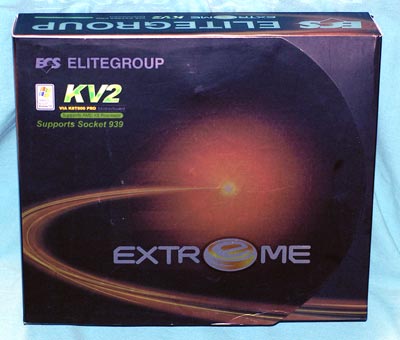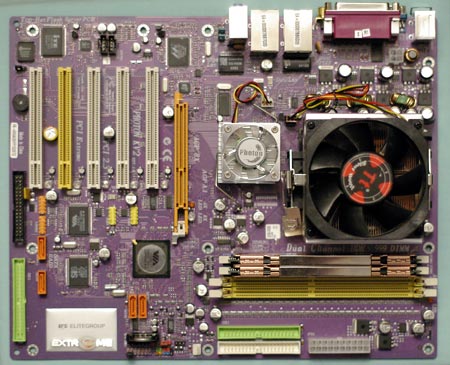Socket 939 Roundup: Battle at the Top
by Wesley Fink on July 30, 2004 8:00 AM EST- Posted in
- Motherboards
ECS KV2 Extreme: Features and Layout
| ECS KV2 Extreme Motherboard Specifications | |
| CPU Interface | Socket 939 Athlon 64 |
| Chipset | VIA K8T800 PRO/VT8237 |
| Bus Speeds | 200MHz to 511MHz (in 1MHz increments) |
| CPU Ratios | 4x - 20x in 0.5x increments |
| PCI/AGP Speeds | Disabled, 66.0, 75.4 |
| HyperTransport | 1GHz to 200MHz (5x-1x) |
| Core Voltage | 0.825V to 1.55V in .025V increments |
| DRAM Voltage | 2.50V to 2.7V in 0.05V increments |
| AGP Voltage | 1.45V, 1.53V, 1.57V, 1.60V |
| Chipset Voltage | None |
| Memory Slots | Four 184-pin DDR DIMM Slots Dual-Channel Unbuffered Memory to 4GB |
| Expansion Slots | 1 AGP 8X Slot 5 PCI Slots |
| Onboard SATA/RAID | 2 SATA 150 drives by VIA VT8237 plus 2 SATA 150 by SiS 180 Can be combined in RAID 0, 1, 0+1, JBOD |
| Onboard IDE | Two Standard VIA ATA133/100/66 (4 drives) plus 2 IDE 133/100/66 by SiS 180 |
| Onboard USB 2.0/IEEE-1394 | 8 USB 2.0 ports supported by VIA VT8237 2 IEEE 1394a FireWire Ports by VIA VT6307 |
| DUAL Onboard LAN | Gigabit Ethernet by Marvel 88E8001 plus 10/100 by VIA VT6103L |
| Onboard Audio | Realtek ALC655 6-Channel with SPDIF |
| Tested BIOS | 1.1A |

ECS hopes that the bronze-foil box with a feature flap clearly announces that the ECS KV2 Extreme is a premium board. The Extreme name is reserved for the top ECS boards, and with the Socket 939 currently a premium board, the KV2 announces that ECS wants to be a contender at the top.
The KV2 Extreme even has the individual interior boxes that we first saw on Abit motherboards, carefully fitted to protect the manuals and brackets . This should not come as a complete surprise, since ECS also manufactures some motherboards for Abit. The KV2 is a 6-layer, 3-phase design, which includes all the bells and whistles that you have come to expect from top-of-the-line motherboards. This includes Dual RAID, Dual LAN, 4 SATA ports, 2 Firewire ports, provisions for 6 IDE drives, and active North Bridge cooling.

Just so you don't miss it, ECS even has a silver plaque on the purple KV2 announcing it is a member of the Extreme series. The layout of the board is generally excellent, showing great attention to the smallest details. ECS has placed the ATX, IDE, and floppy connectors in our preferred upper right edge location. Even the extra IDE for the 5th and 6th IDE is out of the way for the PCI slots.
The BIOS adjustments on the early versions of the KV2 were very sparse, but ECS quickly updated the KV2 Extreme with the CPU Frequency adjustments, ratios, and PCI/AGP lock that you would expect on a premium 939 motherboard. Our only complaints about the available options are that the vCore is still rather meager with a top of 1.55V; 1.70 volts would have been preferred. Also, the vDIMM to only 2.7V is low for a board that intends to compete in this arena - a range to at least 2.85V and preferably 3.0V would be better.
The range of CPU Frequency adjustments to 511 is incredible, but we found that we could only use a very small portion of that frequency range. While we verified that the AGP/PCI lock is working with a PCI Geiger, we were still limited in our overclocking attempts compared to other VIA boards in this roundup.










83 Comments
View All Comments
harsaphes - Sunday, October 10, 2004 - link
just set up my a8v board. no go on firewire, will not see ipod or external firewire drive. any idea?...bad board maybe?kd4yum - Thursday, August 5, 2004 - link
Fender - Wednesday, August 4, 2004 - link
The first words in this review confirm that you should never buy a VIA product before they revised it! (KT266 to 400 saga anyone?)Also, it's oddly that Hyperions used here are 8 months old...
It could be interesting if you include, in your tests, any possible issue concerning OS installation or updating drivers (from the CD included in the box to the updated drivers from the manufacturer's site) because this is what happens to most buyers out there. Remember that you're testing a 64bit CPU with a 32bit OS, and drivers development will be a further support insurance.
Wesley Fink - Tuesday, August 3, 2004 - link
#79 - Page 13 is corrected. That error slipped past 3 proofreaders. Thank you for alerting us.Sidewinder0010 - Tuesday, August 3, 2004 - link
the k8t neo2 overclocking page has a typo that was throwing me off"much lower than the 290 on the K8T Neo2"
That should be changed to k8n neo2
Compddd - Friday, July 30, 2004 - link
Wesley, did Asus say when the A8V Rev 2.0 will be hitting Retail Stores like Fry's, Best Buy, etc?thebluesgnr - Friday, July 30, 2004 - link
How does the lower bandwidth (4900Mb/s) affect real world performance?One more thing, perhaps the MSI K8T Neo2 Platinum references should be changed to MSI K8T Neo2-FIR? That's the name of this board on MSI's site, there's no mention of it being a Platinum board. And here's a link of all the boards in the Platinum series: http://www.msicomputer.com/pressrelease/platinum.a...
Off-Topic: Wesley, will there be reviews on AnandTech of Socket A mobos based on the nForce2 Ultra 400Gb and VIA KT880 chipsets? They offer the exact same features of the mobos on this roundup, and with the new Semprons and the good XP-Mobiles I suspect a lot of your readers are still interested in this socket.
Sorry for the off-topic.
Wesley Fink - Friday, July 30, 2004 - link
#75 - You are confusing boards as MSI had TWO boards in the roundup. We had no problems at all with the first or second K8N Neo2 (based on nForce3 Ultra) we tested, and that is the board that received the Gold Editors Choice. The MSI K8T Neo2, based on the VIA K8T800 PRO, was the problem board and we definitely did NOT give the K8T Neo2 an award.#74 - On page 5 we talk about the memory bandwidth differences in 1T and 2T command rates: "The best performance is at a Command Rate of 1T, and the Abit AV8 was completely stable at a 1T setting with 2 DIMMs. Standard memory bandwidth measured with SiSoft Sandra 2004 SP2 shows a 6000 MB/s bandwidth with 1T Command Rate compared to a 5000 MB/s bandwidth with a 2T setting." This is also mentioned on page 11: "While a full memory comparison of the nVidia and VIA chipsets is beyond the scope of this roundup, we did run several SiSoft Sandra 2004 SP2 runs of the memory test module. At default settings, and the aggressive 2-2-2-10 timings on the FX53, the nF3-250 Ultra showed memory bandwidth in the 6100 range for FPU and Float. The same test on the VIA K8T800 PRO boards showed memory bandwidth in the 6000 range. Performance of both chipsets at the 1T setting was very similar. 2T Command Rates, with everything else the same, generated bandwidths of 4900 to 5000Mb/second."
Z80 - Friday, July 30, 2004 - link
Considering your statement "Our concern is based on the fact that we went through 3 K8T Neo2 boards before we got one that really worked" I'm surprised that you went ahead and gave the MSI board your gold award. I see that MSI is being sued for intentionally using capacitors that were made with an improperly-formulated electrolyte solution. My personal experience with MSI quality assurance was never good at least back in the day it wan't but maybe they have changed like you say OCZ has? I'll stick with Asus and Abit, thank you.SignalPST - Friday, July 30, 2004 - link
quote from the article:"We even found that all six of the tested motherboards performed at the fastest timings available and a 2T Command Rate with 4 DIMMs on board, so even that is a non-issue."
Does that mean that if 4 sticks of ram are installed, there won't be a performance hit and it will work just as fast as 2 sticks installed?